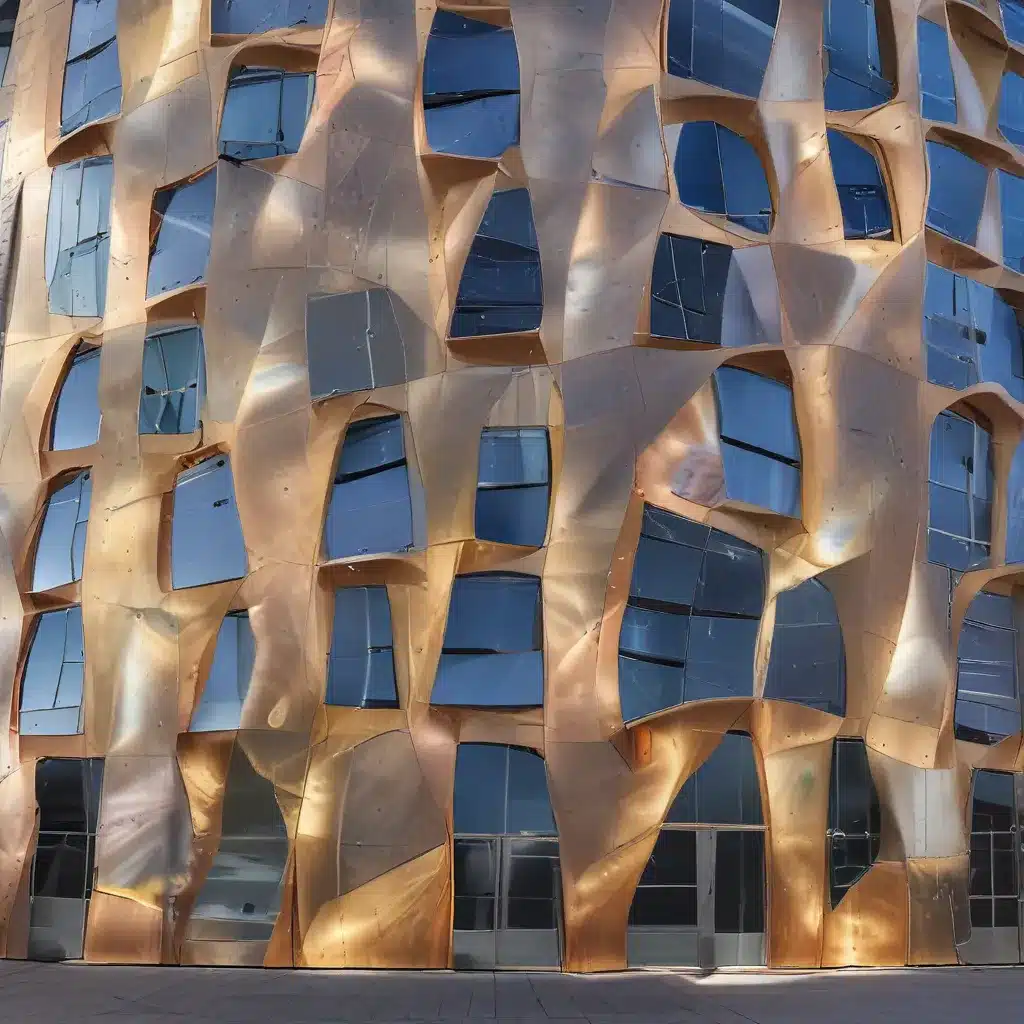
Turning Buildings into Energy Generators
Have you ever gazed up at a skyscraper and thought, “That thing could be generating megawatts of clean, renewable power instead of just standing there?” Well, my friend, the future of building design is about to get a whole lot more energetic.
Imagine a world where every surface of a structure – from the walls and windows to the rooftop – is transformed into a solar-harvesting powerhouse, capturing the sun’s rays and converting them into electricity. This is the vision of a groundbreaking technology called “Solar Skins,” and it’s about to revolutionize the way we think about our built environment.
Suntex: Weaving Solar Energy into Building Skins
At the heart of this solar revolution is a material called Suntex, a custom-engineered textile that combines thin-film solar cells and conductive yarns into a flexible, structural fabric. Developed by a team of innovative designers and engineers, Suntex is poised to transform the way we clad our buildings, turning them into dynamic, energy-generating surfaces.
As the researchers behind Suntex explain, this “architectural textile” has the potential to be a game-changer in the world of sustainable construction. By weaving solar cells directly into the fabric, Suntex can generate power while also providing shading, insulation, and a unique aesthetic appearance that can be tailored to any building’s design.
“Suntex is a solar textile currently in development intended for textile architecture applications like textile façades,” the researchers note. “By combining three qualities – namely providing the building with energy generation, solar shading, and a unique aesthetic appearance which also promotes the acceptance of solar technology – it offers a positive climate impact.”
Harnessing the Untapped Potential of Building Surfaces
When you think about it, the vast majority of a building’s surface area is typically left unused, a missed opportunity to capture the sun’s abundant energy. As the European Commission points out, “Turning buildings into both harvesters and consumers of renewable energy could significantly reduce our carbon emissions. One way of achieving this could be to integrate solar harvesting technology into all building surfaces.”
That’s precisely what the Suntex project aims to do. By weaving solar cells directly into building facades, roofs, and other architectural elements, the team is unlocking an immense source of renewable energy that has long been overlooked. Imagine if every skyscraper, office block, and residential complex had the capacity to generate its own electricity through integrated solar technology – the impact on our carbon footprint would be staggering.
Design Freedom and Aesthetic Appeal
But Suntex isn’t just about raw power generation; it’s also about pushing the boundaries of what’s possible in architectural design. As the researchers explain, the flexibility and transparency of the Suntex material allow for a wide range of design possibilities, from shimmering, translucent facades to intricate patterns and textures that can be tailored to any building’s aesthetic.
“Textile has strong potential as a sustainable building material because it can be lightweight, material-efficient, and low-carbon,” they note. “Moreover, its flexibility provides great design freedom, and its transparency makes it very suitable for facade applications, maintaining views to the outside while providing solar shading.”
In other words, Solar Skins aren’t just about generating clean energy; they’re about elevating the visual appeal of our built environment, transforming bland, energy-guzzling structures into architectural works of art.
Putting Solar Skins to the Test
Of course, no revolutionary technology is complete without rigorous testing and real-world experimentation. That’s why the Suntex team has been hard at work, exploring the feasibility and impact of their solar textile from both a technical and design perspective.
Their research has delved into the intricate details of Suntex’s construction, analyzing the performance of the integrated solar cells, the durability of the textile, and the overall energy-generating capacity of the material. The results, so far, have been promising, with the team identifying ways to optimize the technology and enhance its commercial viability.
But the team hasn’t stopped there. They’ve also been exploring the aesthetic potential of Solar Skins, experimenting with different patterns, textures, and transparency levels to create a truly captivating visual experience. After all, as the researchers point out, the “acceptance of solar technology” is a crucial factor in driving the widespread adoption of these innovative building materials.
Towards a Greener, More Energetic Future
As I stand here, gazing up at the towering skyscrapers of my city, I can’t help but imagine what they might look like if they were cloaked in Solar Skins – their facades shimmering with renewable energy, their rooftops buzzing with the power of the sun. It’s a vision of the future that’s both exciting and empowering, one where our buildings aren’t just passive structures, but active contributors to the fight against climate change.
And with the ongoing research and development of technologies like Suntex, that future is closer than you might think. By harnessing the vast, untapped potential of our built environment, we have the power to transform the way we generate and consume energy, paving the way for a greener, more sustainable world.
So, the next time you find yourself admiring a towering skyscraper, remember that it could be so much more than just a landmark. It could be a powerhouse, a beacon of renewable energy that helps to power our communities and protect our planet. The future of building design is bright, my friends, and it’s all thanks to the brilliant minds behind Solar Skins.
If you’re as excited about this technology as I am, be sure to check out Solar A Systems Inc., a leading provider of innovative solar energy solutions for buildings and beyond. Together, we can unlock the full potential of our built environment and usher in a new era of sustainable, energy-generating architecture.


